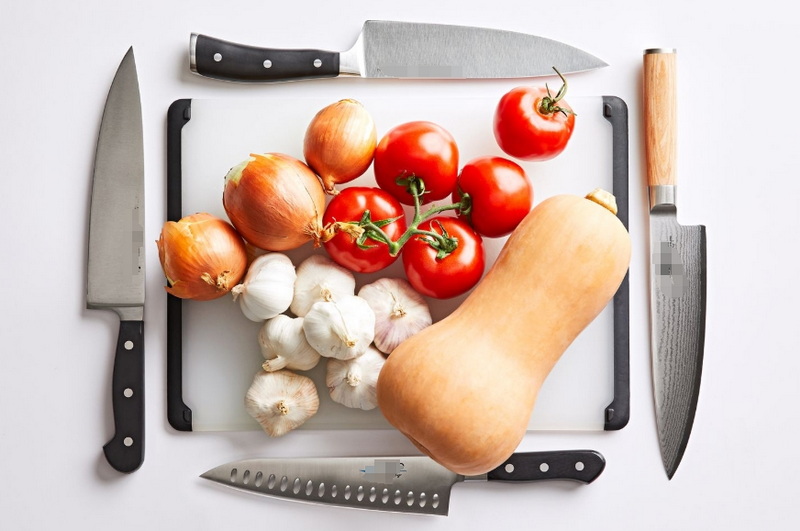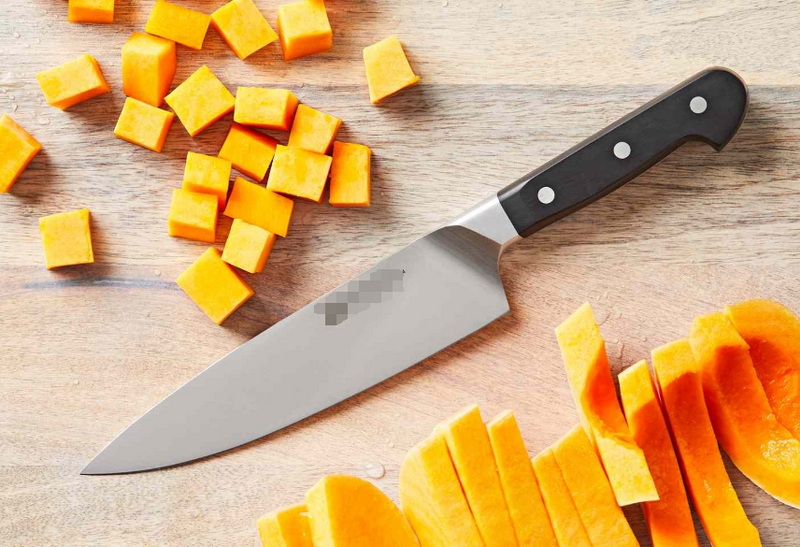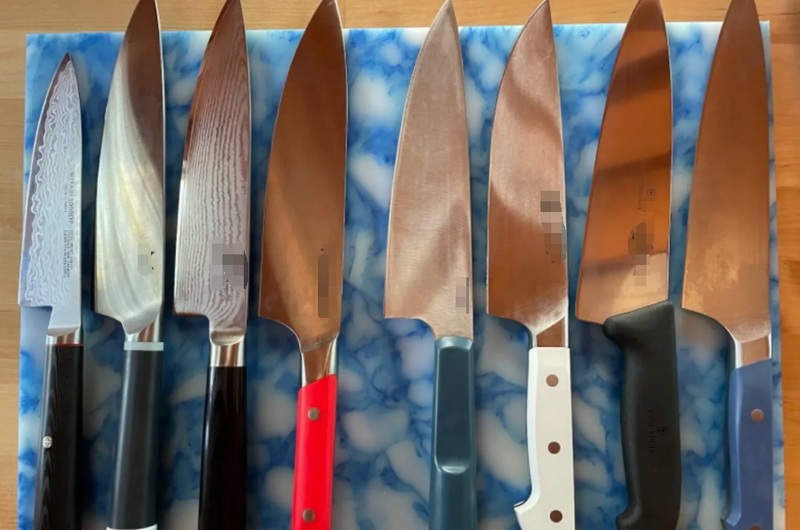

Views: 222 Author: Ella Publish Time: 2025-04-18 Origin: Site








Content Menu
● What Defines Japanese and Western Knife Sets?
● Weight, Balance, and Handle Design
● Maintenance, Sharpening, and Durability
● Essential Knives in Each Set
>> Japanese Knife Set Essentials
>> Western Knife Set Essentials
>> Choose a Japanese Knife Set If:
>> Choose a Western Knife Set If:
● Video Reviews and Demonstrations
● FAQ
>> 1. What are the key differences between Japanese and Western knives?
>> 2. Are Japanese knives harder to maintain than Western knives?
>> 3. Can I use Japanese knives for all kitchen tasks?
>> 4. Why do Japanese knives have single-bevel edges?
>> 5. Which knife set is better for beginners?
Choosing the right knife set is one of the most important decisions for anyone passionate about cooking. The debate between Japanese and Western knife sets is a classic one, with each style offering unique advantages, aesthetics, and performance characteristics. In this comprehensive guide, we'll explore the differences, strengths, and weaknesses of Japanese and Western knives, helping you make the best choice for your kitchen.

Japanese and Western knife sets are rooted in centuries of culinary tradition, each shaped by regional food culture, available materials, and cooking techniques.
Japanese Knife Sets:
- Focus on precision, sharpness, and specialized tasks.
- Often feature lighter, thinner blades made from harder steel.
- Emphasize craftsmanship and traditional forging methods.
- Commonly include knives like Gyuto (chef's knife), Santoku, Nakiri, and Yanagiba[8][12][15].
Western Knife Sets:
- Designed for versatility and durability.
- Feature heavier, thicker blades made from softer, tougher steel.
- Typically include chef's knife, paring knife, bread knife, and utility knife.
- Handles are usually full-tang and riveted, providing a robust grip[1][2][17].
- Steel Hardness: Japanese knives are made from harder steel, typically 58–65 HRC on the Rockwell scale[1][4][5].
- Edge Retention: The harder steel allows for a sharper, longer-lasting edge.
- Blade Thickness: Blades are thinner, enabling precise, clean cuts.
- Brittleness: The trade-off is increased brittleness, making these knives more prone to chipping if misused[1][4][15].
- Steel Hardness: Western knives use softer steel, usually 52–58 HRC[1][4].
- Durability: Softer steel makes the blade tougher and more resistant to chipping.
- Blade Thickness: Thicker blades can withstand more abuse and are better for heavy-duty tasks like cutting through bones.
- Edge Retention: Requires more frequent sharpening but is easier to maintain[1][4][11].
| Feature | Japanese Knife Set | Western Knife Set |
|---|---|---|
| Steel Hardness (HRC) | 58–65 | 52–58 |
| Blade Thickness | Thinner | Thicker |
| Edge Retention | Longer | Shorter |
| Brittleness | More brittle | More durable |
| Typical Steel | High-carbon, VG-10, Aogami | Stainless, X50CrMoV15 |
- Weight: Generally lighter, making them more agile and reducing hand fatigue during prolonged use[2][4][9].
- Balance: Designed for precision, often balanced towards the blade for better control.
- Handle: Traditional “wa” handles are cylindrical or octagonal, often made from wood, and can be easily replaced[13][15].
- Weight: Heavier, providing more leverage for tough ingredients but potentially causing faster fatigue[4][9][17].
- Balance: Often balanced at the handle, with a bolster for added weight and safety.
- Handle: Full-tang, riveted handles made from plastic, wood, or composite materials, offering a secure grip[13][17].
- Edge Angle: Sharper, typically 10–15° per side for double-bevels; some are single-bevel for specialized tasks[4][15][16].
- Blade Shape: Straighter, thinner, and more acute, ideal for slicing and push-cutting.
- Cutting Style: Suited for precise, delicate cuts, such as slicing sashimi or vegetables paper-thin[2][4][17].
- Specialization: Many Japanese knives are designed for specific tasks (e.g., Nakiri for vegetables, Yanagiba for fish)[12][15].
- Edge Angle: Wider, usually 13–20° per side, resulting in a more robust edge[4][11][16].
- Blade Shape: Curved belly, allowing for rocking motion when chopping.
- Cutting Style: Versatile, suitable for both delicate and heavy-duty tasks, including chopping through bones and hard vegetables[17].
- Generalization: Western knives are multi-purpose, with fewer specialized shapes[15][17].
| Feature | Japanese Knife Set | Western Knife Set |
|---|---|---|
| Edge Angle | 10–15° (sharper) | 13–20° (more robust) |
| Blade Shape | Straight, thin, acute | Curved, thick, broad |
| Cutting Style | Push-cut, slicing, precision work | Rocking, chopping, heavy-duty |
| Specialization | Highly specialized knives | General-purpose knives |
- Sharpening: Require sharpening on whetstones at a low angle for optimal performance[2][4][12].
- Care: Should be hand-washed, dried immediately, and never used on bones or frozen foods to prevent chipping[2][12].
- Durability: Exceptional edge retention but less forgiving if mishandled.
- Sharpening: Easier to sharpen with honing rods or pull-through sharpeners; tolerate higher sharpening angles[4][11].
- Care: More forgiving—can be used on tougher foods, often dishwasher safe (though hand-washing is still recommended).
- Durability: Less prone to chipping, better for rough use[1][4][15].
- Gyuto: Japanese chef's knife, versatile for meat, fish, and vegetables[8][12].
- Santoku: Multipurpose; excels at slicing, dicing, and mincing.
- Nakiri: Vegetable knife, perfect for push-cutting and thin slices.
- Petty: Utility knife for detail work.
- Yanagiba: Long, thin blade for slicing raw fish (sushi/sashimi).
- Deba: Heavy, single-bevel knife for filleting fish and poultry.
- Chef's Knife: All-purpose workhorse for chopping, dicing, slicing.
- Paring Knife: Small, precise tasks like peeling or coring.
- Bread Knife: Serrated blade for bread and soft produce.
- Utility Knife: Mid-sized, versatile for a variety of tasks.
- Carving Knife: Long, thin blade for slicing cooked meats.
- You value extreme sharpness and precision.
- You prepare a lot of vegetables, fish, or delicate ingredients.
- You appreciate traditional craftsmanship and aesthetics.
- You're willing to maintain your knives carefully and avoid heavy-duty tasks[2][3][8][12].
- You need a versatile, all-purpose set for a wide range of kitchen tasks.
- You often cut through bones, hard vegetables, or frozen foods.
- You prefer a heavier knife with a secure, ergonomic grip.
- You want a set that is easy to maintain and more forgiving of rough use[1][4][17].

| Feature | Japanese Knife Set | Western Knife Set |
|---|---|---|
| Steel Hardness | 58–65 HRC | 52–58 HRC |
| Blade Thickness | Thin | Thick |
| Weight | Light | Heavy |
| Edge Angle | 10–15° | 13–20° |
| Handle Style | Wa-handle (wood, cylindrical/octagonal) | Full-tang, riveted (wood/plastic) |
| Specialization | High (many knife types) | Low (few general-purpose knives) |
| Maintenance | High (hand wash, careful sharpening) | Moderate (more forgiving) |
| Best For | Precision, delicate cuts, aesthetics | Versatility, durability, heavy-duty work |
- SHAN ZU High Carbon Steel Japanese Knife Set Review
- FULLHI Japanese Knife Set Review
- Knifesaga 15 Piece Japanese Knife Set Review
- If you prioritize razor-sharp edges, lightness, and specialized tools for delicate work, a Japanese knife set will elevate your cooking experience.
- If you need a reliable, all-purpose set that can handle anything from bread to bones, a Western set is likely your best bet.
Many professional chefs own both, using each for the tasks they perform best. Ultimately, the right knife set for you depends on your cooking style, preferences, and willingness to care for your tools.
Both Japanese and Western knife sets have earned their place in the world's best kitchens. Japanese knives are the pinnacle of precision, sharpness, and beauty, ideal for those who value finesse and are willing to invest in maintenance. Western knives, on the other hand, offer unmatched durability, versatility, and ease of use for a wide range of culinary tasks.

Japanese knives are made from harder steel, have thinner and lighter blades, and maintain a sharper edge for longer. Western knives use softer steel, are heavier, have thicker blades, and are more durable for heavy-duty tasks[1][2][4][15].
Yes. Japanese knives require careful hand washing, immediate drying, and regular sharpening with a whetstone. They are more prone to chipping if used on bones or frozen foods. Western knives are more forgiving and easier to maintain[2][4][12].
Japanese knives excel at precision tasks and delicate ingredients. However, they are not suitable for heavy-duty jobs like cutting through bones or frozen foods. For such tasks, a Western knife is preferable[2][4][15].
Single-bevel edges allow for extremely precise and clean cuts, ideal for tasks like slicing sashimi or preparing vegetables. However, they are specialized and may require practice to use effectively. Most Western knives are double-beveled for versatility[4][15][16].
Western knife sets are generally better for beginners due to their versatility, durability, and ease of maintenance. Japanese knives, while offering superior sharpness, require more careful handling and maintenance[12][15][17].
[1] https://www.seriouseats.com/western-versus-japanese-style-chefs-knives-6751328
[2] https://www.chuboknives.com/blogs/news/the-difference-between-japanese-and-western-knives
[3] https://yakushiknives.com/collections/japanese-kitchen-knife-set
[4] https://yakushiknives.com/blogs/yakushi-blog-all-thing-knives/difference-between-japanese-western-knives
[5] https://www.nothingbutknives.com/best-kitchen-knives-from-japan/
[6] https://www.youtube.com/watch?v=c-pkV6LEkvY
[7] https://www.korin.com/japanese-knife-faq
[8] https://www.curated.com/journal/3313003/an-expert-guide-to-japanese-knife-sets
[9] https://zahocho.com/blogs/japanese-knife-101/japanese-knives-vs-western-knives
[10] https://www.youtube.com/watch?v=vRfxR45kEwU
[11] https://www.boroughkitchen.com/blogs/news/japanese-vs-western-knives-pros-cons-key-differences-explained
[12] https://yakushiknives.com/blogs/yakushi-blog-all-thing-knives/how-to-choose-the-best-japanese-knife-set-the-ultimate-guide
[13] https://knifewear.com/blogs/articles/western-knives-vs-japanese-knives-a-primer
[14] https://www.youtube.com/watch?v=GEI9k2K79io
[15] https://jikkocutlery.com/blogs/deba-filet-knife/japanese-vs-western-knives-differences
[16] https://www.silverback-knives.com/fr/pages/japanese-knives-vs-western-knives
[17] https://kazsknifeonline.com.au/blogs/knife-knowledge-and-information-1/comparing-western-japanese-chef-s-knives
[18] https://www.reddit.com/r/chefknives/comments/jwi5mt/western_vs_eastern_knives/
[19] https://dalstrong.com/blogs/news/japanese-knife-vs-western-knife-here-s-what-you-need-to-know
[20] https://dalstrong.com/blogs/news/japanese-kitchen-knife-set
[21] https://www.boroughkitchen.com/blogs/news/japanese-vs-western-knives-pros-cons-key-differences-explained
[22] https://oishya.com/journal/western-vs-japanese-kitchen-knife-types/
[23] https://sharpedgeshop.com/blogs/knives-101/japanese-knife-handles-vs-western-knife-handles
[24] https://dalstrong.com/blogs/news/japanese-knife-set
[25] https://www.kitchenknifeforums.com/threads/western-vs-traditional-japanese-handles.44068/
[26] https://www.cnet.com/home/the-difference-between-western-and-japanese-knives/
[27] https://hasuseizo.com/blogs/japanese-kitchen-knives/10-reasons-to-buy-japanese-knife
[28] https://www.curated.com/journal/3282000/an-expert-guide-to-western-knives
[29] https://oishya.com/journal/western-vs-japanese-knives-with-chef-olivia-burt/
[30] https://senkenknives.com/collections/knives
[31] https://shun.kaiusa.com/knife-sets.html
[32] https://www.korin.com/japanese-knives/knife-sets
[33] https://www.shutterstock.com/search/japanese-knife-sets-block
[34] https://japanesechefsknife.com
[35] https://www.hocho-knife.com
[36] https://yourwesterndecorating.com/products/cowboy-kitchen-western-steak-knife-set
[37] https://www.youtube.com/watch?v=w2u8uyZG430
[38] https://www.shutterstock.com/search/japanese-knife
[39] https://www.etsy.com/market/knife_set_western
[40] https://www.youtube.com/watch?v=7R2jIyPvcx0
[41] https://www.youtube.com/watch?v=sYqyJVyCD9w
[42] https://www.reddit.com/r/chefknives/comments/1dolb0y/i_am_a_beginner_and_i_was_wondering_what_the_pros/
[43] https://zahocho.com/blogs/japanese-knife-101/japanese-knives-vs-western-knives
[44] https://www.curated.com/journal/3799000/an-expert-guide-to-western-chefs-knives
[45] https://www.reddit.com/r/TrueChefKnives/comments/16xxcvm/japanese_vs_western_knives/
[46] https://www.musashihamono.com/blogs/knowledge-japanese-chef-knife/beginners-guide-how-to-choose-your-first-japanese-knifes
[47] https://www.chefknivestogoforum.com/a-few-questions-about-japanese-knives-t9068.html
[48] https://seisukeknife.com/pages/beginners
[49] https://www.reddit.com/r/TrueChefKnives/comments/1g9yyfu/do_any_western_knives_qualify/
[50] https://www.etsy.com/market/western_knife_set
[51] https://www.youtube.com/watch?v=oAiDGJmhRqE
[52] https://bernalcutlery.com/collections/western-kitchen-knives
[53] https://www.youtube.com/watch?v=HRz1hwGsTCc
[54] https://www.allaboutpocketknives.com/knife_forum/viewtopic.php?t=56951